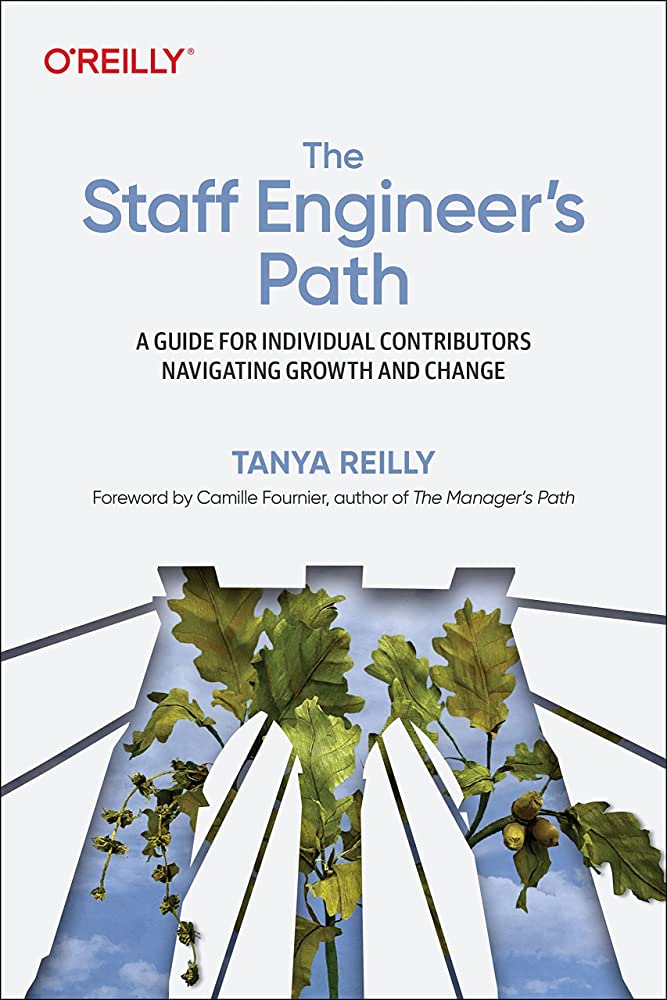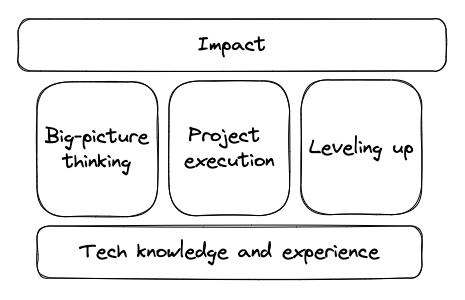Thoughts on "The Staff Engineer's Path"
I recently read “The Staff Engineer’s Path” by Tanya Reilly. This post shares some thoughts and highlights some points I found interesting about the book.

I really enjoyed the book and I highly recommend it to engineers of all levels. Even if you aren’t at staff+ level it will give you a really good idea of what is expected and a “north star” to aim for in terms of professional and personal development. For staff+ level engineers it contains an enormous amount of great practical advice about how to approach the role. The first edition was only published in 2022, but I wish I had the opportunity to read this earlier in my career! I’m definitely going to be dipping into this book occasionally for guidance in future.
The three pillars
There can be a lot of ambiguity about what is expected of staff+ engineers, and even when the expectation is articulated, it can be difficult to know how to achieve it practically. In particular, I think it can be difficult to understand how to scale your impact from being team-level to organization-level.
This book seeks to give engineers a framework and methodology to approach the role. It unpacks the staff+ engineer role into three pillars of, big-picture thinking, execution, and leveling up (others). The pillars require a solid foundation of technical knowledge and experience, and together they will lead to achieving greater impact.

The sections of the book are dedicated to these three pillars. Breaking down the role in this way made the book and its advice feel well organized and understandable.
Big-picture thinking
The first pillar focuses on building the skills to see the big picture. Organizations need engineers that can see the big picture and provide context for making good decisions. If all engineers in the organization only have context relevant to their team’s interests and responsibilities, then decision making will always arrive at the local maxima. This means that solutions will be chosen that may be the best for the immediate scope of the team, but perhaps not the best for the organization as a whole.
The first part of this section focused on defining your role in terms of scope, responsibility and influence. The key take-away for me was that “your job will be a weird shape sometimes, and that’s OK.” There is no one-size-fits-all, and I think the point is that you need to be flexible and adapt to fit what the organization needs for your particular area of responsibility.
“At staff+ levels, your manager should be bringing you information and sharing context, but you should be telling them what’s important just as much as the other way around.”
I thought this was a great point and a good sign that an engineer at this level is building the wider context necessary to be effective in their role.
The section continues with discussing how to “map the terrain” of a role to better understand the context of how your area of responsibility fits into the bigger picture. The key point for me here was to talk with peers outside your group to understand their goals and what success looks like for them.
The final part of this section was about how to document a technical vision and strategy. This is the output of big-picture thinking and will form the basis for decision making. A technical vision is a picture of what we envision our systems to look like in the future. It’s the state that our systems will be in after all the work is done. It describes the destination, but importantly, it doesn’t describe the road to get there!
”(a technical vision) doesn’t set out to make all of the decisions, but it should remove sources of conflict or ambiguity and empower everyone to choose their own path while being confident that they’ll end up at the right place.”
Providing a technical vision with “guardrails” is a much more efficient use of a staff+ engineer’s time than trying to micro-manage every detail. The former approach scales impact much more effectively.
A technical strategy is a plan for how to achieve the vision. The author makes the point that there should be no pressure to innovate here or come up with “insightful game-changing solutions.” Good technical strategy is often pretty boring.
Project execution
This section deals with the second pillar and covers topics like time management, social capital, leading big projects, and dealing with stalled or blocked projects. As much as you might want to, you can’t do everything and be in control of every detail of a large project. Choosing how to spend time to execute on a project can be challenging, and the book does a good job of describing how and what to prioritize.
The author touches on the concept of “social capital,” which is the idea that you bank capital through a mix of trust, credibility, friendship, and favors for your peers. In turn, you can use this capital at opportune moments to help you achieve your goals.
You will build credibility as a professional every time you take on a chaotic situation and make it easier for everyone else to understand.
Using this social capital well is another important way of maximizing your influence in the organization and leveraging it to get things done at scale. Don’t waste your social capital on fights that in the big picture are unimportant, or you don’t really care about.
The book’s advice for leading big projects was also great, pointing out the need for clear definitions of success, driving it rather than letting things happen, and effective communication.
“…, and–the number one tool for success–writing things down.”
When leading big projects there will be times when you are faced with difficulties and are feeling out of your depth. The author suggests that voicing this uncertainty to everyone is generally not a good idea, and that you should find one or two peers that you can be open and unsure with. You need peers that you can be open with about the difficulties and will let you bounce ideas off them for validation.
Leveling up (others)
The final section of the book, dealing with the third pillar, focuses on leveling up others around you and how to be a good influence at scale. I think this was the most helpful section of the book to me personally. I’ve often struggled to understand practically how to achieve that part of my role. This book made me realize that “mentorship” and leveling up others can take many forms, not just limited to activities with direct interaction.
The first chapter of this section is titled “You’re a Role Model Now (Sorry),” and is all about how staff+ engineers are role models for the rest of the organization whether they like it or not. Our words and actions influence the engineering culture of the organization, for good or bad. Reading this section made me realize that being a good role model counts as “mentorship” and can have a powerful ability to level up others around you, often to a greater extent than more deliberate approaches. So on the one hand it made me feel much more confident that I have gone some way to fulfilling the mentorship aspect of my role, but on the other hand it made me realize how much of a responsibility it is to be a good role model. The author made me see that it has greater impact than I previously thought.
The book shares a lot of good advice for being a good role model. The advice is laid out as a general set of principles and good behaviors grouped into these categories:
- Be competent
- Be responsible
- Remember the goal
- Look ahead
One point in the “look ahead” section that I particularly liked and rang true with me was to “optimize for maintenance, not creation.” This can often cause the creation of new systems to take longer, but in my experience it’s almost always worth it. Most of our time is spent maintaining systems and if we can reduce that burden we will be able to move faster as an organization.
Another section I thought was great and had good advice was about “being a catalyst” in order to scale your ability to level up others.
“Creating robots, policies, and processes that reinforce your message scales further than being a guardrail for individual colleagues.”
Much of the advice in this section also focused on making sure that others can work autonomously, and are given the opportunities to do so.
Opportunities can be much more valuable than advice. Think about who you’re sponsoring and delegating to. Share the spotlight in your team.
Final thoughts
This was a great book and I highly recommend giving it a read. It’s given me a lot more confidence, and the way the book broke the role down has made it easier to see what areas I would like to focus on personally.
I loved that the advice was clear and practical, and really demystifies the core aspect of the role–how to have impact and influence at scale.